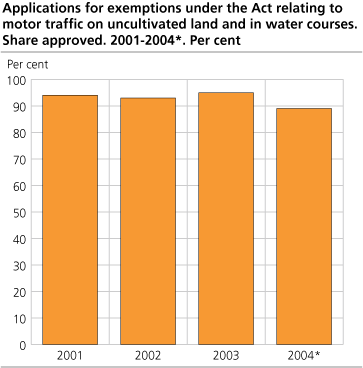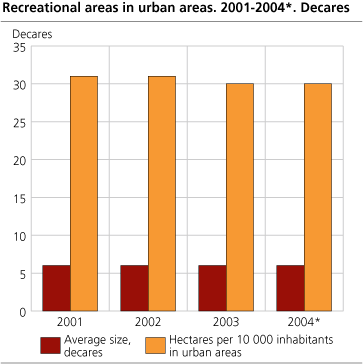Content
Published:
This is an archived release.
Signs of stricter policy for motor traffic in uncultivated areas
Norwegian municipalities approved 89 per cent of the applications for motor traffic in uncultivated areas in 2004. This is down from 95 per cent in 2003. The number of applications is not evenly distributed between the municipalities, but this has little effect on the share of exemptions granted.
Motor traffic in uncultivated areas is banned in principle. However, under the Motor Traffic and Environment Act, local government authorities may grant exemptions from this rule and allow motor traffic for certain purposes. No data on actual traffic are available, but KOSTRA provides information on exemptions granted by local government authorities.
Municipal land conservation
The conservation of areas for environmental purposes is generally regulated by legal acts administered by central government. But the Planning and Building Act gives municipalities the opportunity to protect areas of special value against development. In 2004, about 10 per cent of all plans adopted contained areas protected by the municipality, about the same level as in 2003.
Recreation in urban areas
Around 80 per cent of the Norwegian population live in urban areas. Urban land comprises only 0.7 per cent of the total land area, and, consequently, there are many and different interests in these areas. Access to green areas in the urban areas is therefore, to a large extent, dependent on whether such areas are secured in municipal land use plans. In 2004, each municipality had 49 such areas on average. The size of these areas in relation to the population has been stable, although there seem to be a falling trend in the four years that the KOSTRA reporting has existed. If this is the case, it is a signal that the population in urban areas is increasing without the authorities securing more green areas in the municipal plans.
For general information on KOSTRA, see http://www.ssb.no/english/subjects/00/00/20/kostra_en/ . More detailed tables on the subject will be available in English on 15 June.
See also: Land use planning in municipalities and counties, preliminary figures 2004
Find more figures
Find detailed figures from Environmental management in local and county authorities
Additional information
Contact
-
Ingeborg Hauge
E-mail: ingeborg.hauge@ssb.no
tel.: (+47) 95 87 66 56
-
Jørn Kristian Undelstvedt
E-mail: jorn.kristian.undelstvedt@ssb.no
tel.: (+47) 94 50 68 64


